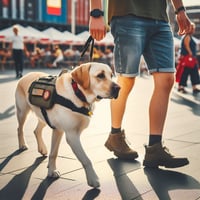In a world where the incredible bond between humans and dogs goes beyond companionship, service...
Severe Separation Anxiety: Effective Crate Training Techniques
Dealing with a dog suffering from severe separation anxiety can be challenging and emotionally draining. Crate training can be a valuable tool to help alleviate separation anxiety and provide a safe space for your dog when you're away. In this article, we will guide you through the process of crate training, offering valuable techniques and practical tips to create a positive association with the crate, reduce anxiety, and promote your dog's well-being.
Introduction to the Crate:
- Start by introducing the crate as a positive and comfortable space for your dog. Place the crate in a quiet area of your home, preferably in a room where your dog feels secure. Make the crate inviting by adding cozy bedding, familiar scents, and some favorite toys.
Gradual Acclimation:
- Allow your dog to explore the crate at their own pace. Initially, keep the crate door open and encourage your dog to voluntarily enter by placing treats or toys inside. Use positive reinforcement and praise when they enter or show interest in the crate. Gradually increase the duration of time your dog spends inside the crate while providing treats, praise, and comforting words.
Creating Positive Associations:
- Associate the crate with positive experiences by feeding your dog their meals near the crate or inside it. Offer treats and toys exclusively inside the crate to create a positive association. Use verbal cues such as "crate" or "kennel" while they are entering the crate, so they start associating those words with the action.
Gradual Separation:
- Once your dog is comfortable spending time in the crate, gradually introduce short periods of separation. Begin by closing the crate door for a few seconds, then gradually increase the duration as your dog becomes more relaxed. Be patient and progress at a pace that ensures your dog remains calm and comfortable.
Departure Cues:
- Avoid creating a highly charged departure routine that signals your dog you are leaving. Instead, practice low-key departures and arrivals to minimize anxiety. Ignore your dog for a few minutes before leaving and after returning home to avoid reinforcing anxious behavior.
Addressing Separation Anxiety:
- If your dog exhibits severe separation anxiety, consult with a professional dog trainer or a veterinary behaviorist for a comprehensive treatment plan. They may recommend behavior modification techniques, desensitization exercises, and, in some cases, medication to assist with anxiety management.
Example Scenario:
Imagine having a dog with severe separation anxiety named Max. You begin crate training by gradually introducing Max to the crate, placing treats and toys inside to entice him. Over time, Max willingly enters the crate, and you start closing the door for short durations, rewarding him for calm behavior. As you progress, you begin incorporating gradual periods of separation, starting with a few minutes and gradually extending the time. By consistently using positive reinforcement and providing a safe space, Max's anxiety decreases, and he starts associating the crate with comfort and security.
Conclusion:
Crate training can be a powerful tool in managing severe separation anxiety in dogs. By introducing the crate gradually, creating positive associations, and progressively increasing periods of separation, you can help your dog feel more secure and reduce anxiety levels. Remember, every dog is unique, and patience, consistency, and professional guidance are key when dealing with severe separation anxiety. With time and proper training techniques, you can provide your dog with a safe and comforting crate experience, ultimately improving their well-being and quality of life.
.png?width=50&height=50&name=Profile%20round%20logo%20(1).png)



